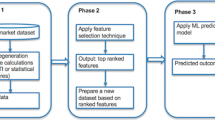Abstract
Volatility modeling is crucial for risk management and asset allocation; this is an influential area in financial econometrics. The central requirement of volatility modeling is to be able to forecast volatility accurately. The literature review of volatility modeling shows that the approaches of model averaging estimation are commonly used to reduce model uncertainty in order to achieve a satisfactory forecasting reliability. However, those approaches attempt to forecast more reliable volatilities by integrating all forecasting outcomes equally from several volatility models. Forecasting patterns generated by each model may be similar. This may cause redundant computation without improving forecasting reliability. The proposed multivariate volatility modeling method which is called the fuzzy-method-involving multivariate volatility model (abbreviated as FMVM) classifies the individual models into smaller scale clusters and selects the most representative model in each cluster. Hence, repetitive but unnecessary computational burden can be reduced, and forecasting patterns from representative models can be integrated. The proposed FMVM is benchmarked against existing multivariate volatility models on forecasting volatilities of Hong Kong Hang Seng Index constituent stocks. Numerical results show that it can obtain relatively lower forecasting errors with less model complexity.



Similar content being viewed by others
References
Christoffersen, P.F., Diebold, F.X.: How relevant is volatility forecasting for financial risk management? Rev. Econ. Stat. 82, 12–23 (2000)
Yiu, K.F.C.: Optimal portfolios under a value-at-risk constraint. J. Econ. Dyn. Control 28(7), 1317–1334 (2004)
Jorion, P.: Value at Risk: The New Benchmark for Managing Financial Risk, 3rd edn. McGraw Hill Professional, New York (2006)
Yiu, K.F.C., Liu, J.Z., Siu, T.K., Ching, W.K.: Optimal portfolios with regime switching and value-at-risk constraint. Automatica 46(6), 979–989 (2010)
Liu, J.Z., Yiu, K.F.C., Siu, T.K., Ching, W.K.: Optimal investment–reinsurance with dynamic risk constraint and regime switching. Scand. Actuar. J. 2013(4), 263–285 (2013)
van den Broek, K.: Long-term insurance products and volatility under the Solvency II framework. Eur. Actuar. J. 4(2), 315–334 (2014)
Yiu, K.F.C., Wang, S.Y., Mak, K.L.: Optimal portfolios under a value-at-risk constraint with applications to inventory control in supply chains. J. Ind. Manag. Optim. 4(1), 81 (2008)
Wang, S.Y., Yiu, K.F.C., Mak, K.L.: Optimal inventory policy with fixed and proportional transaction costs under a risk constraint. Math. Comput. Model. 58(9), 1595–1614 (2013)
Bollerslev, T.: Generalized autoregressive conditional heteroskedasticity. J. Econom. 31(3), 307–327 (1986)
Engle, R., Kroner, K.F.: Multivariate simultaneous generalized ARCH. Econom. Theory 11(01), 122–150 (1995)
Bollerslev, T.: Modelling the coherence in short-run nominal exchange rates: a multivariate generalized ARCH model. Rev. Econ. Stat. 72(3), 498–505 (1990)
Alexander, C.O. (ed.): Orthogonal GARCH. In: Mastering Risk, vol. 2, pp. 21–38. Financial Times-Prentice Hall, London (2001)
Engle, R.: Dynamic conditional correlation: a simple class of multivariate generalized autoregressive conditional heteroskedasticity models. J. Bus. Econ. Stat. 20(3), 339–350 (2002)
Cappiello, L., Engle, R.F., Sheppard, K.: Asymmetric dynamics in the correlations of global equity and bond returns. J. Financ. Econom. 4(4), 537–572 (2006)
Pesaran, M.H., Schleicher, C., Zaffaroni, P.: Model averaging in risk management with an application to futures markets. J. Empir. Finance 16(2), 280–305 (2009)
Batuwita, R., Palade, V.: FSVM-CIL: fuzzy support vector machines for class imbalance learning. IEEE Trans. Fuzzy Syst. 18(3), 558–571 (2010)
Batuwita, R., Palade, V., Bandara, D.C.: FSVM-CIL: fuzzy support vector machines for class imbalance learning. Int. J. Artif. Intell. Tools 20(3), 425–455 (2011)
Serguieva, A., Hunter, J.: Fuzzy interval methods in investment risk appraisal. Fuzzy Sets Syst. 142(3), 443–466 (2004)
Chen, S.M., Chang, Y.C.: Multi-variable fuzzy forecasting based on fuzzy clustering and fuzzy rule interpolation techniques. Inf. Sci. 180, 4772–4783 (2010)
Bezdek, J.C., Ehrlich, R., Full, W.: FCM: the fuzzy c-means clustering algorithm. Comput. Geosci. 10(2–3), 191–203 (1984)
Pathak, A., Pal, N.R.: Clustering of mixed data by integrating fuzzy, probabilistic, and collaborative clustering framework. Int. J. Fuzzy Syst. 18(3), 339–348 (2016)
Zhang, T., Chen, L., Chen, C.P.: Clustering algorithm based on spatial shadowed fuzzy c-means and I-Ching operators. Int. J. Fuzzy Syst. 18(4), 609–617 (2016)
Dalman, H.: An interactive fuzzy goal programming algorithm to solve decentralized bi-level multiobjective fractional programming problem. arXiv preprint arXiv:1606.00927 (2016)
Dalman, H., Güzel, N., Sivri, M.: A fuzzy set-based approach to multi-objective multi-item solid transportation problem under uncertainty. Int. J. Fuzzy Syst. 18(4), 716–729 (2015)
Dalman, H.: Uncertain programming model for multi-item solid transportation problem. Int. J. Mach. Learn. Cybern. 1–9 (2016)
Andersen, T.G., Bollerslev, T., Diebold, F.X., Ebends, H.: Fuzzy interval methods in investment risk appraisal. J. Financ. Econ. 61, 43–76 (2001)
Sheppard, K.: MFE matlab function reference. Financ. Econom. (Computer software manual) (2009)
Acknowledgement
This work was supported by the PolyU grant G-YBCV.
Author information
Authors and Affiliations
Corresponding author
Appendix: A Model Classification Example of Low-Dimensional Cases
Appendix: A Model Classification Example of Low-Dimensional Cases
Assume that we have 4 assets and use one-day-ahead forecasting. The classification results are shown in Tables 4, 5, 6, 7, 8, 9, 10, 11 and 12. The first row in each table shows our benchmark. Other rows show different clustering results with the first model in each row/cluster being the representative model for this cluster; for instance, in Table 12, DCC(2, 2) and ADCC(2, 2) are grouped in cluster 6, and the DCC(2, 2) is the representative model.
Rights and permissions
About this article
Cite this article
Wei, ZK., Yiu, KF.C., Wong, H. et al. A Novel Multivariate Volatility Modeling for Risk Management in Stock Markets. Int. J. Fuzzy Syst. 20, 116–127 (2018). https://doi.org/10.1007/s40815-017-0298-x
Received:
Revised:
Accepted:
Published:
Issue Date:
DOI: https://doi.org/10.1007/s40815-017-0298-x




